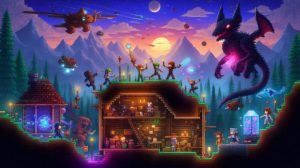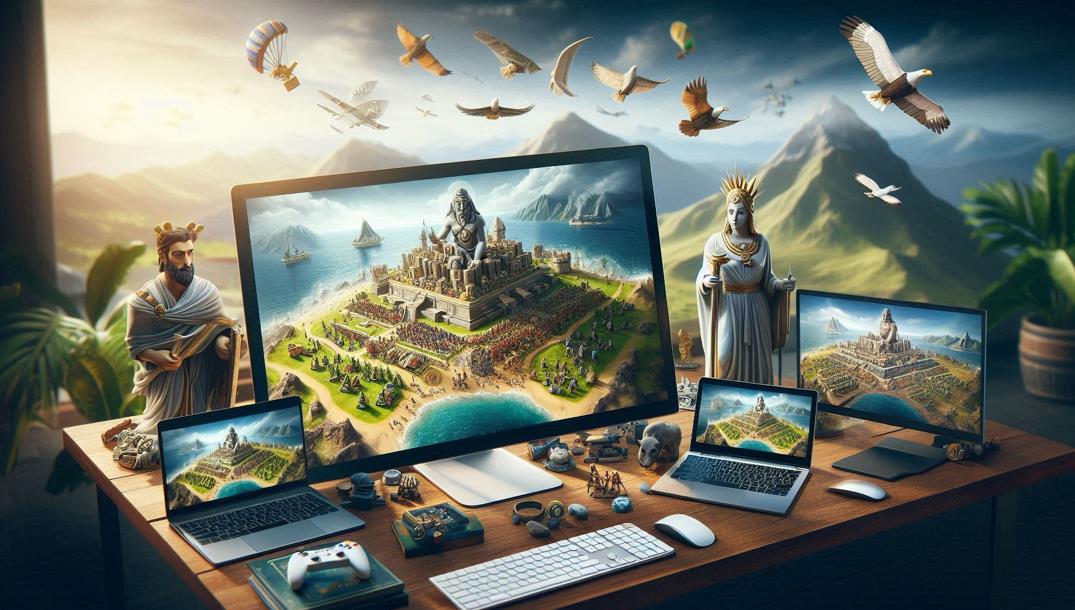How to Create a Free Terraria Server?
If you’ve ever wanted to embark on epic adventures in the vibrant, blocky world of Terraria alongside your friends, setting up a free server is the perfect way to make that happen! This beloved sandbox game offers endless possibilities, from crafting intricate structures to battling fierce monsters. However, the true magic of Terraria comes to life when you explore its expansive landscapes with a group of fellow players.
Creating your own server not only enhances your gaming experience but also gives you the power to customize your gameplay environment to suit your preferences. Whether you’re looking to build a cozy village, tackle challenging bosses, or simply hang out with friends, a dedicated server can transform your gaming sessions. In this guide, we’ll walk you through the steps to set up your very own free Terraria server, ensuring you can dive into the action with your friends in no time.
What is Terraria?

Terraria is a popular sandbox adventure game developed by Re-Logic, combining elements of exploration, crafting, building, and combat. Released in 2011, the game offers a pixelated 2D world filled with diverse biomes, enemies, and treasures to discover. Players can mine resources, craft weapons and tools, build structures, and face off against various bosses. With a rich array of gameplay options, including single-player and multiplayer modes, Terraria has captured the hearts of gamers around the world, providing endless hours of fun and creativity.
Why Set Up a Terraria Server?
Setting up a Terraria server allows you to enhance your gaming experience by playing with friends and other players in a shared world. Here are a few compelling reasons to create your own server:
Collaborative Play: Playing together fosters teamwork, allowing players to build elaborate structures, tackle challenging bosses, and explore vast worlds collaboratively. You can share resources, ideas, and strategies, making the experience more enjoyable.
Customization: Hosting your own server grants you control over the game settings. You can modify rules, select world sizes, and adjust difficulties, tailoring the gameplay experience to suit your group’s preferences.
Stability: Dedicated servers typically provide a more stable and consistent gameplay experience compared to joining public servers, which can often suffer from lag and downtime. Hosting your own server ensures that you can play whenever you want without interruptions.
Privacy: You control who can join by setting up your own server. You can create a private space for just you and your friends, reducing the likelihood of encountering disruptive players that can be common in public servers.
Community Building: Hosting a server can foster a sense of community among players. As you gather a group of friends or fellow players, you can organize events, challenges, or just regular play sessions that can create lasting friendships.
How to Create a Free Terraria Server?

Step 1: Choose Your Hosting Method
When it comes to hosting your Terraria server, you have a couple of options. You can host it on your own PC or use a dedicated hosting service. Here’s a breakdown of both:
Self-Hosting: This is the simplest way to create a server. You’ll run the server software directly from your computer, which is great for small groups of friends. To do this, make sure your computer meets the minimum requirements to run both the game and the server software simultaneously. Keep in mind that your computer needs to be running for the server to be active, and your internet connection may affect performance. It’s ideal for casual play sessions but can be less reliable for larger groups due to the potential for lag.
Dedicated Hosting Services: If you prefer not to use your own computer, several online platforms offer free or low-cost dedicated Terraria hosting services. These services usually provide better performance, 24/7 uptime, and the ability to host larger groups without affecting your personal computer’s performance. With dedicated hosting, you won’t need to worry about your PC’s power consumption or keeping it on all the time. Some popular options include Aternos, Server.pro, and Nodecraft, each with different features and capabilities.
Step 2: Download Terraria Server Software

If you choose to self-host, you’ll need to download the server software. Here’s how:
Download SteamCMD: Go to the SteamCMD website and download the command-line version of Steam. This tool allows you to download the Terraria server files. It’s a straightforward process, but make sure to follow the instructions for your specific operating system (Windows, macOS, or Linux).
Install SteamCMD: After downloading, extract the files to a folder on your computer. You can place this folder anywhere, but it’s helpful to keep it organized.
Download Terraria:
Open the Command Prompt (Windows) or Terminal (macOS/Linux) and navigate to the SteamCMD directory. You can do this by using the cd command to change directories.
Type the following commands:
login anonymous
force_install_dir ./terraria_server/
app_update 105600 validate
quit
This will download the latest version of the Terraria server to the specified directory. The download may take some time, depending on your internet speed, but it will ensure you have the most recent updates and features.
Step 3: Configure Your Server
Once you have the server software downloaded, you’ll need to configure it:
Navigate to Your Server Folder: Open the terraria_server folder you created during the download. Inside, you will find the server executable file and configuration files.
Run the Server: Open the Command Prompt, navigate to your server folder using the cd command, and run:
terraria-server.exe
Server Configuration: You’ll be prompted to enter various settings, such as your server name, password (if desired), world size, and difficulty. Here’s what each setting means:
Server Name: Choose a catchy name for your server that reflects its theme or purpose. This is what players will see when they search for servers to join.
Password: Optional, but adding a password can restrict access to only your friends, enhancing security and privacy.
World Size: Choose from small, medium, or large worlds based on your preference and how much space you want to explore. A larger world offers more exploration opportunities but may take longer to generate.
Difficulty: Set the game difficulty to your liking—normal, expert, or master. This affects enemy strength and the game’s overall challenge.
Save Settings: Once you’ve configured your settings, save and exit. Be sure to remember your server’s IP address and port number for later.
Step 4: Set Up Port Forwarding
To allow friends to connect to your server, you’ll need to set up port forwarding on your router:
Find Your IP Address: Open Command Prompt and type ipconfig. Look for your IPv4 address. This is the local IP address of your computer, which you will use in the port forwarding settings.
Access Your Router Settings: Enter your router’s IP address in your web browser. Common addresses include 192.168.1.1 or 192.168.0.1. Log in using your credentials. If you haven’t changed them, the default username and password can often be found on the router itself or in the user manual.
Port Forwarding Settings: Find the port forwarding section and create a new rule:
Service Name: Name it something like “Terraria Server.”
Port Range: Set it to 7777 (default for Terraria).
Local IP: Enter your computer’s IPv4 address that you found earlier.
Protocol: Select TCP/UDP, as Terraria uses both protocols for gameplay.
Save Settings: Make sure to save your changes before exiting the router settings. This step is crucial; without it, your friends won’t be able to connect to your server.
Step 5: Invite Friends to Join
Now that your server is running, it’s time to invite your friends:
Share Your IP Address: Give your friends your public IP address. You can find this by searching “what is my IP” on Google. This is the address they will use to connect to your server.
Server Connection: They can join your server by opening Terraria, going to the “Multiplayer” menu, and selecting “Join via IP.” They’ll need to enter your IP address and the port number (default is 7777). Make sure they are running the same version of Terraria as you are to avoid compatibility issues.
Step 6: Enjoy Your Game!

With everything set up, you and your friends can now enjoy Terraria together! Explore, build, and battle monsters in your custom world. Remember, communication is key, so consider using voice chat platforms like Discord for a better gaming experience.
Troubleshooting Tips
Firewall Issues: If friends can’t connect, check your firewall settings to ensure Terraria is allowed through. You may need to create a new inbound rule in your firewall settings for the server executable.
Lag Issues: If you experience lag, consider reducing the number of players or upgrading your internet plan. Additionally, try closing any unnecessary applications running on your computer to free up resources.
Dynamic IP Address: If your ISP provides a dynamic IP address, it may change frequently. Consider using a dynamic DNS service to keep track of your IP address more easily.
Creating a free Terraria server is an exciting way to enhance your gaming experience. With the above steps, you can set up your server and start adventuring quickly.
FAQs on How to Create a Free Terraria Server
Can I create a free Terraria server without any special software?
Yes, you can create a free Terraria server using the official Terraria server software, which can be downloaded directly from the Terraria website or Steam. However, you may also use third-party hosting services that offer free server options.
What are the system requirements for running a Terraria server?
The system requirements for hosting a Terraria server are relatively modest. You’ll need at least 2 GB of RAM and a stable internet connection. However, the more players you expect, the more resources you’ll need.
How do I invite friends to join my Terraria server?
Once your server is running, share your public IP address with your friends, along with the port number (default is 7777). They can enter this information in the Terraria multiplayer menu to join your server.
Is there a limit to how many players can join my free Terraria server?
The default limit for players on a Terraria server is typically 8, but this can be adjusted in the server configuration files. However, the maximum number of players may also depend on the hosting service you choose.
Can I customize my Terraria server settings?
Absolutely! You can modify various settings in the server configuration files, including the world size, difficulty, and player limits. This allows you to tailor the gameplay experience to your liking.
Do I need to keep my computer running for friends to play on my server?
Yes, if you’re hosting the server from your own computer, it must remain on and running the server software for your friends to connect. Alternatively, using a dedicated server hosting service can alleviate this requirement.
Are there any risks to hosting a free Terraria server?
Hosting a server comes with some risks, such as potential security vulnerabilities and the need to manage player interactions. It’s essential to keep your software updated and only invite trusted friends to maintain a safe gaming environment.









